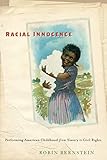Racial Innocence : Performing American Childhood from Slavery to Civil Rights / Robin Bernstein.
Material type: TextSeries: America and the Long 19th Century ; 16Publisher: New York, NY : New York University Press, [2011]Copyright date: ©2011Description: 1 online resourceContent type:
TextSeries: America and the Long 19th Century ; 16Publisher: New York, NY : New York University Press, [2011]Copyright date: ©2011Description: 1 online resourceContent type: - 9780814787076
- 9780814787090
- 305.800973 23/eng/20230216
- online - DeGruyter
| Item type | Current library | Call number | URL | Status | Notes | Barcode | |
|---|---|---|---|---|---|---|---|
 eBook
eBook
|
Biblioteca "Angelicum" Pont. Univ. S.Tommaso d'Aquino Nuvola online | online - DeGruyter (Browse shelf(Opens below)) | Online access | Not for loan (Accesso limitato) | Accesso per gli utenti autorizzati / Access for authorized users | (dgr)9780814787090 |
restricted access online access with authorization star
http://purl.org/coar/access_right/c_16ec
2013 Book Award Winner from the International Research Society in Children's Literature2012 Outstanding Book Award Winner from the Association for Theatre in Higher Education 2012 Winner of the Lois P. Rudnick Book Prize presented by the New England American Studies Association 2012 Runner-Up, John Hope Franklin Publication Prize presented by the American Studies Association2012 Honorable Mention, Distinguished Book Award presented by the Society for the Study of American Women WritersPart of the American Literatures Initiative Series Beginning in the mid nineteenth century in America, childhood became synonymous with innocence-a reversal of the previously-dominant Calvinist belief that children were depraved, sinful creatures. As the idea of childhood innocence took hold, it became racialized: popular culture constructed white children as innocent and vulnerable while excluding black youth from these qualities. Actors, writers, and visual artists then began pairing white children with African American adults and children, thus transferring the quality of innocence to a variety of racial-political projects-a dynamic that Robin Bernstein calls "racial innocence." This phenomenon informed racial formation from the mid nineteenth century through the early twentieth. Racial Innocence takes up a rich archive including books, toys, theatrical props, and domestic knickknacks which Bernstein analyzes as "scriptive things" that invite or prompt historically-located practices while allowing for resistance and social improvisation. Integrating performance studies with literary and visual analysis, Bernstein offers singular readings of theatrical productions from blackface minstrelsy to Uncle Tom's Cabin to The Wonderful Wizard of Oz; literary works by Joel Chandler Harris, Harriet Wilson, and Frances Hodgson Burnett; material culture including Topsy pincushions, Uncle Tom and Little Eva handkerchiefs, and Raggedy Ann dolls; and visual texts ranging from fine portraiture to advertisements for lard substitute. Throughout, Bernstein shows how "innocence" gradually became the exclusive province of white children-until the Civil Rights Movement succeeded not only in legally desegregating public spaces, but in culturally desegregating the concept of childhood itself.Check out the author's blog for the book here.
Mode of access: Internet via World Wide Web.
In English.
Description based on online resource; title from PDF title page (publisher's Web site, viewed 01. Nov 2023)


